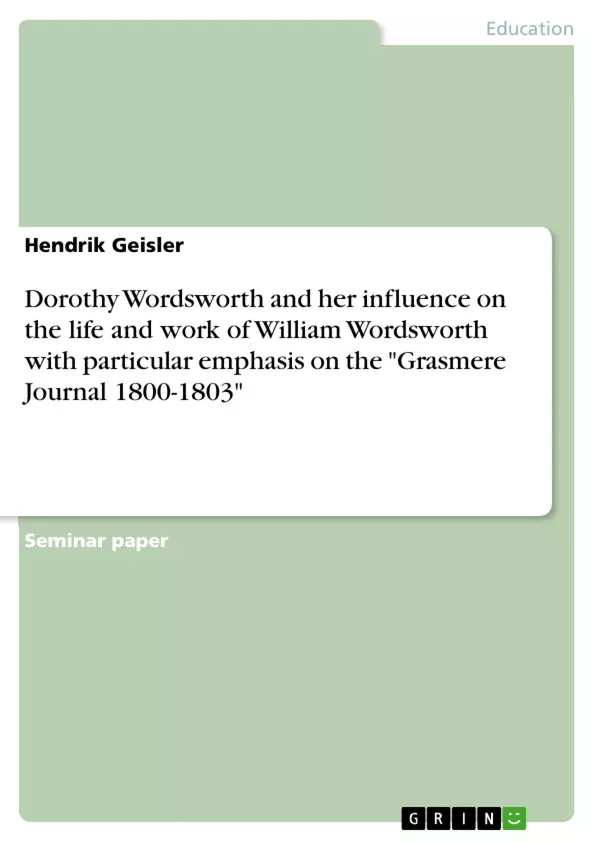"[…] Where’er my footsteps turned,
Her voice was like a hidden bird that sang;
The thought of her was like a flash of light
Or an unseen companionship, a breath
Or fragrance independent of the wind."
With these words the poet laureate William Wordsworth describes the role of
his sister Dorothy in his life (Wordsworth:738). Dorothy Wordsworth had never
intended to be published, praised as a writer or seen as more than the loving
companion to the genius William. In 1799, William and Dorothy moved to Grasmere
to live together in their little Dove Cottage. In 1800, Dorothy began to take down her
observations of nature, the incidents happening in and around Grasmere and her
everyday life with her brother. For the next three years, Dorothy proved her unique
ability of observing and describing her surroundings in nature precisely.
In this seminar paper, the importance of Dorothy Wordsworth’s writing and
its influence on the works of her famous brother will be examined. Following this
preface, Dorothy’s biographical background will be presented. The largest part of the
paper will be the examination of the importance of the Grasmere Journal for the
compositions of William Wordsworth, followed by the fourth chapter, which is about
the general influence Dorothy had on her brother. In the end, a conclusion will sum
up the findings. Due to the large number of findings in literary studies, which
analysed this topic, the seminar paper will show just the major examples of
Dorothy’s influence on William and her role in his literary productions.
Table of Contents
- Preface
- Dorothy Wordsworth
- The Grasmere Journals and their influence on the work of William Wordsworth
- Dorothy’s intention when she began to take down her everyday life
- The cooperation and literary relationship between William Wordsworth and Dorothy Wordsworth
- Dorothy’s importance for William in General
- The most important kind of influence for today’s literary studies
- A second type of influence Dorothy had on William
- A third and for today’s studies rather unimportant form of influence
- As a fourth influence, her role as the addressee or the main theme of some of his poems
- Conclusion
Objectives and Key Themes
This seminar paper aims to examine the importance of Dorothy Wordsworth's writing and its influence on the works of her famous brother William Wordsworth. The paper will begin with a biographical overview of Dorothy, followed by a detailed analysis of the Grasmere Journal and its impact on William's compositions. The fourth chapter explores the general influence Dorothy had on William, and the paper concludes with a summary of the findings.
- The significance of Dorothy Wordsworth's writing in understanding William Wordsworth's work
- The role of the Grasmere Journal as a source of inspiration and themes for William's poetry
- The impact of Dorothy's observations and descriptions of nature on William's creative process
- The close relationship between Dorothy and William and how it influenced their literary works
- The enduring relevance of Dorothy Wordsworth's contributions to the study of Romantic literature
Chapter Summaries
The preface sets the stage for the paper, emphasizing Dorothy Wordsworth's crucial role in William's life and work, particularly in the context of the Grasmere Journal. Chapter 2 provides a biographical sketch of Dorothy, highlighting her early life, her relationship with William, and her move to Grasmere. Chapter 3 delves into the Grasmere Journal, examining its origins, Dorothy's intention in writing it, and how it served as a source of inspiration and material for William's poetry. Several key examples from Dorothy's journal are presented and analyzed in relation to William's poems, demonstrating the profound influence she had on his creative process.
Keywords
This paper focuses on the relationship between Dorothy Wordsworth and William Wordsworth, particularly on Dorothy's influence on her brother's work. Key themes include the Grasmere Journal, Romantic literature, the impact of nature on poetry, and the close sibling bond between Dorothy and William. The paper analyzes specific examples from both Dorothy's writings and William's poetry, emphasizing their interconnectedness and the significant role Dorothy played in shaping her brother's literary genius.
- Citation du texte
- Hendrik Geisler (Auteur), 2012, Dorothy Wordsworth and her influence on the life and work of William Wordsworth with particular emphasis on the "Grasmere Journal 1800-1803", Munich, GRIN Verlag, https://www.grin.com/document/200463



